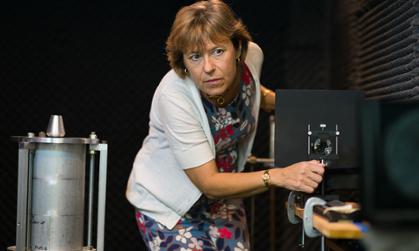Math researcher having a blast with NASA collaboration
NewsSUMMARY: Update 1/10/17: Dr. Caroline Lubert is one of two JMU professors to garner Virginia's highest faculty award. Below is our 2013 story. Lubert, literally a rocket scientist, investigates the noise-generated turbulence of rockets during liftoff. Involving students directly in her research, Dr. Lubert has taken them to NASA, co-presented at conferences, and co-authored academic papers.

|
When a rocket blasted off Sept. 17 on a flight to the International Space Station, JMU mathematics Professor Caroline Lubert was among the invited guests. And while Lubert was excited by the spectacle of a rocket launch — from Wallops Island on Virginia's Eastern Shore — she was equally interested in the thundering sounds the liftoff produced and the sound data that was captured by 70 highly sensitive microphones placed in the vicinity of the launch pad.
Since summer 2012, Lubert has collaborated with NASA and Orbital Sciences Corp., the company that built the Antares rocket for the mission, investigating the earth-shaking acoustical vibrations from rocket launches. She is particularly interested in the sounds that come out of a J-shaped trench that channels the rocket exhaust away from the launch pad during liftoff.
"I'm interested in how the flow behaves in this duct and whether it shows any of the properties I would expect from the Coanda effect," said Lubert, who helped oil companies reduce noise levels at their refineries and rigs while doing her doctoral research in the 1980s. The noise reduction was achieved by creating a saw-toothed nozzle for flares used to burn off excess gas. The jagged nozzle edges changed the frequency of the sound, thus making them less disturbing to human ears.
"They were particularly noisy at 4 Khz, which is a resonance frequency for the human ear," Lubert said. "It sounds worse than it is because your ear is resonating, so if you could just change the frequency, it wouldn't be nearly as bad."
Lubert expects to use the data from the launches to identify peak noise sources and suggest improvements to the design of the flame trench. A key concern for rockets is vibration. The less vibration, the better for the rocket, its payload and, on manned flights, for the astronauts.
”The thing that's interesting about this kind of project is that there are two very different design constraints at work," Lubert said. "On the one hand, there are the engineering considerations related to safely getting the rocket off the ground, and on the other hand, there are the acoustical aspects. Employing the usual ways of making rockets quieter may conflict with one or more design requirements. This is a very common issue in aeroacoustics.”
The sound data is being collected by researchers from NASA's Ames Research Center in Mountain View, Calif. Lubert said the NASA researchers are using beamforming techniques that enable them to get very specific data on where the primary noise comes from. They also get video of the launch, another important feature for Lubert.
"In my acoustics lab, I make sound measurements, but I also perform simultaneous flow visualization. I look at the flow and listen to it at the same time because I want to know if what I'm seeing, features in the flow, tie up with sounds that I'm hearing," she said.
Lubert said she hopes to build a model of the J-trench for testing in her anechoic chamber, a sound-proof room about the size of a shipping container in her Burruss Hall lab. Then she can test different curvatures and different duct lengths to see what effect they have on the aeroacoustics.
"It's a great experience for me being able to work with people like this," Lubert said. "It's fun for me to be on a large-scale project related to my research."

